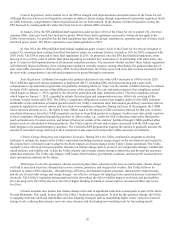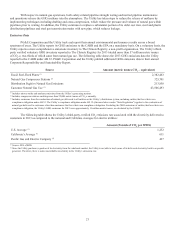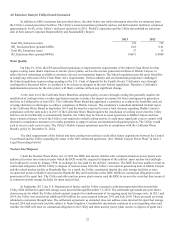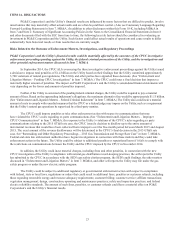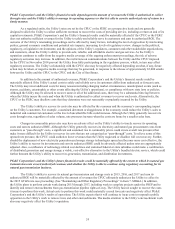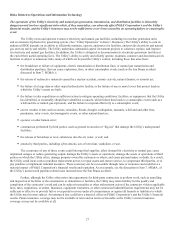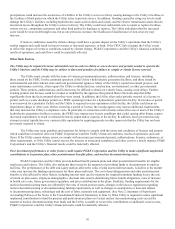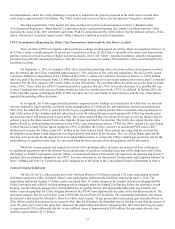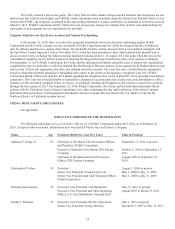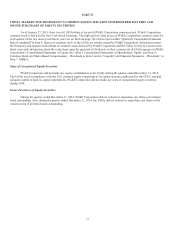PG&E 2014 Annual Report Download - page 38
Download and view the complete annual report
Please find page 38 of the 2014 PG&E annual report below. You can navigate through the pages in the report by either clicking on the pages listed below, or by using the keyword search tool below to find specific information within the annual report.30
precipitation could increase the occurrence of wildfires in the Utility’s service territory causing damage to the Utility’s facilities or
the facilities of third parties on which the Utility relies to provide service. In addition, flooding caused by rising sea levels could
damage the Utility’s facilities, including hydroelectric assets such as dams and canals, and the electric transmission assets that are
located on levees throughout the Utility’s service territory. The Utility could incur substantial costs to repair or replace facilities,
restore service, compensate customers and other third parties for damages or injuries. The Utility anticipates that the increased
costs would be recovered through rates, but as rate pressures increase, the likelihood of disallowance or non-recovery may
increase.
Events or conditions caused by climate change could have a greater impact on the Utility’s operations than the Utility’s
studies suggest and could result in lower revenues or increased expenses, or both. If the CPUC fails to adjust the Utility’s rates
to reflect the impact of events or conditions caused by climate change, PG&E Corporation’s and the Utility’s financial condition,
results of operations, and cash flows could be materially affected.
Other Risk Factors
The Utility may be required to incur substantial costs in order to obtain or renew licenses and permits needed to operate the
Utility’s business and the Utility may be subject to fines and penalties for failure to comply or obtain license renewal.
The Utility must comply with the terms of various governmental permits, authorizations, and licenses, including
those issued by the FERC for the continued operation of the Utility’s hydroelectric generation facilities, and those issued by
environmental and other federal, state and local governmental agencies. Many of the Utility’s capital investment projects, and
some maintenance activities, often require the Utility to obtain land use, construction, environmental, or other governmental
permits. These permits, authorizations, and licenses may be difficult to obtain on a timely basis, causing work delays. Further,
existing permits and licenses could be revoked or modified by the agencies that granted them if facts develop that differ
significantly from the facts assumed when they were issued. In addition, the Utility often seeks periodic renewal of a license or
permit, such as a waste discharge permit or a FERC operating license for a hydroelectric generation facility. If a license or permit
is not renewed for a particular facility and the Utility is required to cease operations at that facility, the Utility could incur an
impairment charge or other costs. Before renewing a permit or license, the issuing agency may impose additional requirements
that may increase the Utility’s compliance costs. In particular, in connection with a license renewal for one or more of the Utility’s
hydroelectric generation facilities or assets, the FERC may impose new license conditions that could, among other things, require
increased expenditures or result in reduced electricity output and/or capacity at the facility. In addition, local governments may
attempt to assert jurisdiction over various utility operations by requiring permits or other approvals that the Utility has not been
previously required to obtain.
The Utility may incur penalties and sanctions for failure to comply with the terms and conditions of licenses and permits
which could have a material effect on PG&E Corporation’s and the Utility’s financial condition, results of operations, and cash
flows. If the Utility cannot obtain, renew, or comply with necessary governmental permits, authorizations, licenses, ordinances, or
other requirements, or if the Utility cannot recover the increase in associated compliance and other costs in a timely manner, PG&E
Corporation’s and the Utility’s financial results could be materially affected.
Poor investment performance or other factors could require PG&E Corporation and the Utility to make significant unplanned
contributions to its pension plan, other postretirement benefits plans, and nuclear decommissioning trusts.
PG&E Corporation and the Utility provide defined benefit pension plans and other postretirement benefits for eligible
employees and retirees. The Utility also maintains three trusts for the purposes of providing funds to decommission its nuclear
facilities. The performance of the debt and equity markets affects the value of plan assets and trust assets. A decline in the market
value may increase the funding requirements for these plans and trusts. The cost of providing pension and other postretirement
benefits is also affected by other factors, including interest rates used to measure the required minimum funding levels, the rate
of return on plan assets, employee demographics, discount rates used in determining future benefit obligations, rates of increase
in health care costs, future government regulation, and prior contributions to the plans. Similarly, funding requirements for the
nuclear decommissioning trusts are affected by the rates of return on trust assets, changes in the laws or regulations regarding
nuclear decommissioning or decommissioning funding requirements as well as changes in assumptions or forecasts related
to decommissioning dates, technology and the cost of labor, materials and equipment. (See Note 2: Summary of Significant
Accounting Policies of the Notes to the Consolidated Financial Statements in Item 8.) If the Utility is required to make significant
unplanned contributions to fund the pension and postretirement plans or if actual nuclear decommissioning costs exceed the
amount of nuclear decommissioning trust funds and the Utility is unable to recover the contributions or additional costs in rates,
PG&E Corporation’s and the Utility’s financial results could be materially affected.


